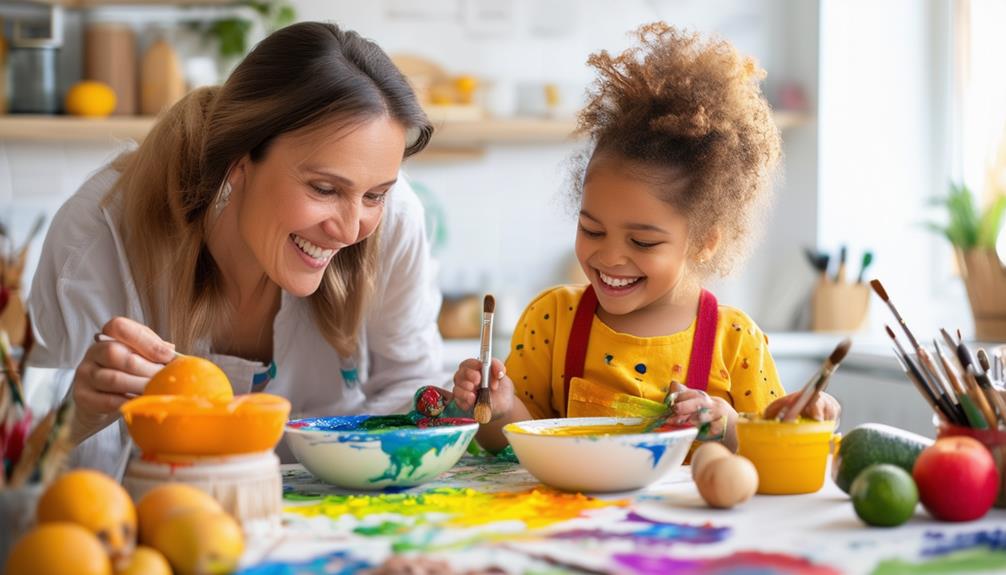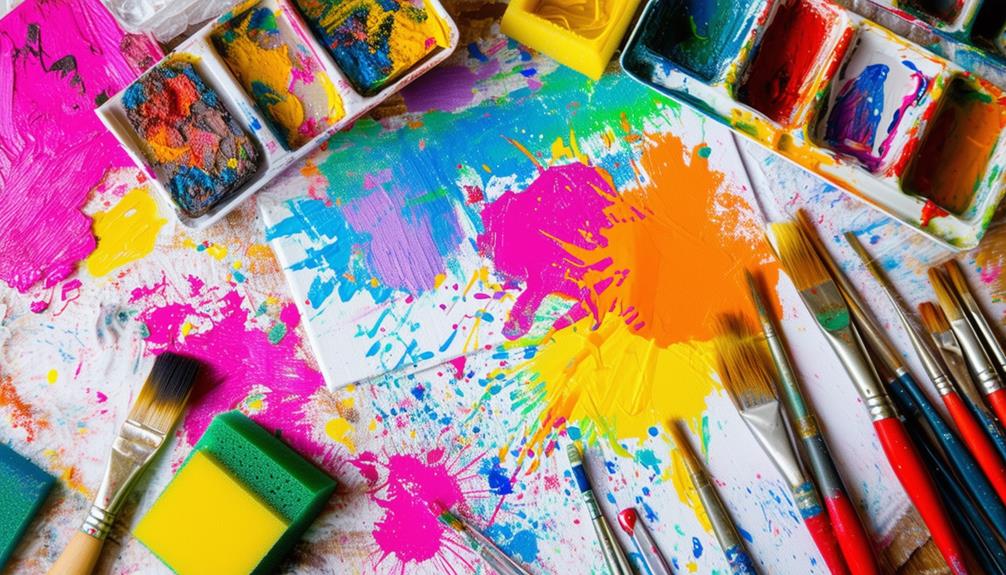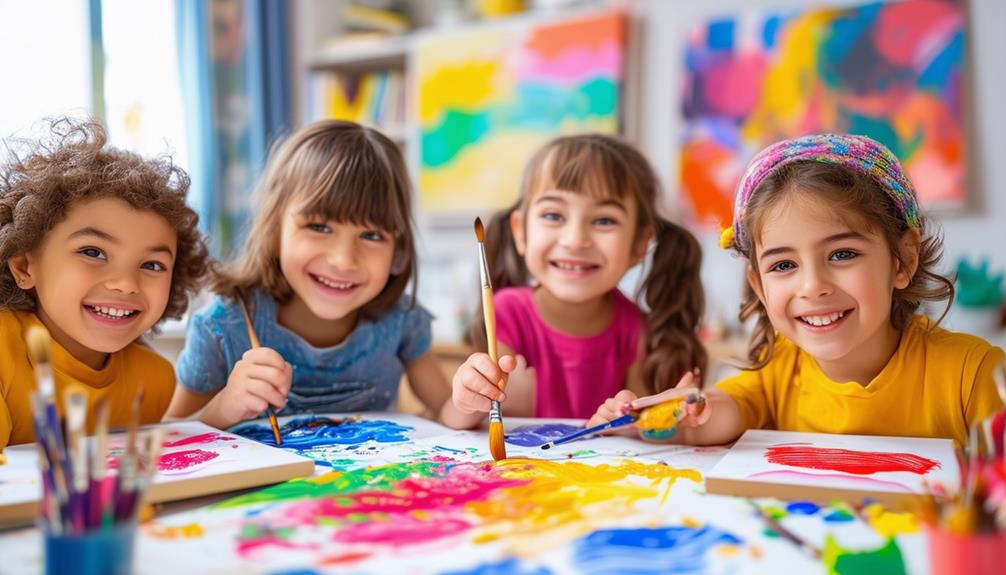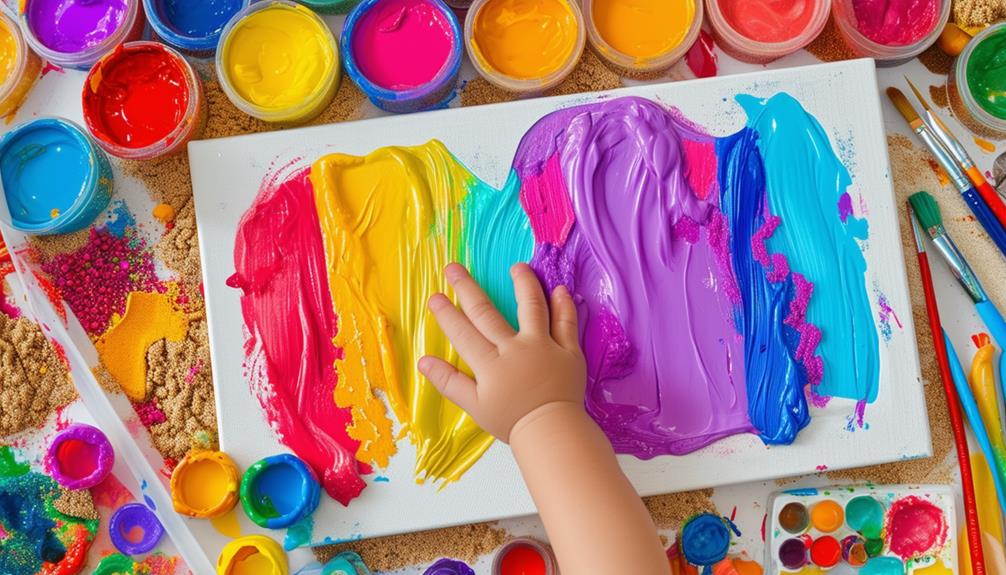How to Set Up a Kid-Friendly Painting Space at Home

To set up a kid-friendly painting area at home, start by choosing a well-lit spot that benefits from natural light to enhance your child's painting experience. Opt for easy-to-clean surfaces like hardwood floors or tiles, and ensure the area is away from valuable items. This setup promotes creativity and simplifies cleanup.
Next, select child-appropriate furniture such as small tables and chairs that are comfortable and easy for kids to use. Stock the area with necessary supplies like washable paints, brushes, paper, and aprons to keep your young artist engaged and organized.
Choosing the Ideal Space
Setting up a kid-friendly painting area begins with finding a well-lit spot that offers plenty of natural light. Natural lighting helps kids see colors vividly and creates an inviting atmosphere for creativity. Choose a location with easy-to-clean surfaces like hardwood floors or washable rugs to manage inevitable spills or splatters.
Dedicating a specific space for painting allows young artists to express themselves freely without worrying about messes. Ensure this area is away from valuable or delicate items to prevent accidental damage. Additionally, good ventilation is essential. Select a location with proper airflow to dissipate paint fumes or odors, ensuring a safer environment for your children.
Selecting Child-Sized Furniture
After selecting the perfect space, furnish it with child-sized furniture to ensure comfort and safety during painting sessions. Opt for a kids' table and chairs that encourage proper posture, allowing your child to focus on their art without discomfort. Adjustable height options are beneficial, accommodating children at different stages and sizes, making the area versatile and long-lasting.
Choose furniture with rounded edges to minimize the risk of injuries and create a secure environment. Sturdy and durable tables and chairs will withstand the energetic activities children bring to their art projects. Additionally, designs tailored for children can enhance the area's appeal, creating an inviting atmosphere that fosters creativity.
Here's a brief guide to assist you in selecting the appropriate furniture:
| Feature | Advantages | Feeling Evoked |
|---|---|---|
| Child-sized | Proper posture and comfort | Relief and satisfaction |
| Adjustable height | Suitable for different stages | Flexibility and growth |
| Rounded edges | Reduced risk of injury | Safety and peace of mind |
| Sturdy and durable | Long-lasting despite heavy use | Trust and reliability |
| Child-friendly design | Welcoming and stimulating | Joy and creativity |
Stocking Essential Art Supplies
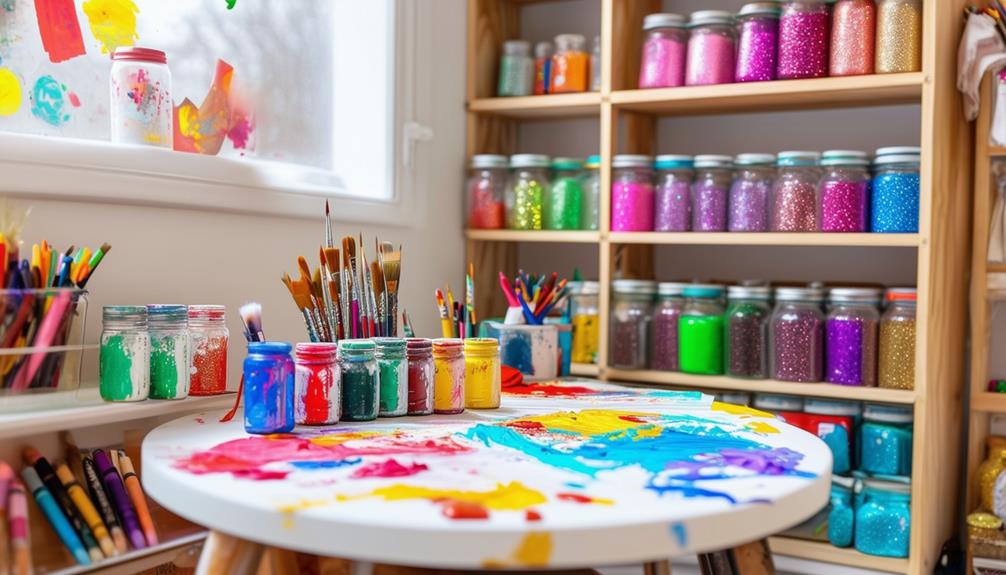
Stocking essential art supplies ensures your child has everything needed for a fun and imaginative painting session. Start with the basics: washable paints, brushes, various types of paper, and smocks to keep clothes clean. Include a wide range of colors to spark creativity and allow experimentation with blending hues.
Expand their artistic horizons by introducing varied textures and mediums. Sponges, stamps, and cotton balls can add distinct textures to their artwork. This variety will keep them engaged and eager to try new techniques. Always choose non-toxic, child-friendly art supplies to ensure safety during creative sessions.
Investing in quality materials, like sturdy paintbrushes and thick, absorbent paper, can significantly enhance the painting experience. These items not only last longer but also produce better results, boosting your child's confidence and excitement.
Organizing the Art Area
Creating an organized art area is essential for fostering a functional and enjoyable space for your child. Utilize shelves, tables, and easels to keep supplies easily accessible. Incorporate child-sized furniture to ensure everything is within reach, promoting independence and maintaining a tidy environment, always ready for creative activities.
Efficient Supply Storage
Creating a well-organized and easily accessible art area involves using open shelving with lower levels for easy reach, enabling kids to independently grab their painting supplies. Open shelving allows you to effectively arrange and separate different types of art materials. Clear containers on these shelves make it simple for kids to see what's inside, promoting self-sufficiency and creativity. Label each container and shelf to help children quickly identify and put away supplies like paints, brushes, and paper.
Child-friendly storage solutions such as baskets and small bins can further enhance organization. These solutions make it easier for kids to grab what they need without creating a mess. Group similar items together—like all paintbrushes in one container and all varieties of paper in another—to streamline the process of finding and storing materials.
Keeping the art area tidy encourages a sense of order and makes it more inviting for kids to engage in painting activities. Consistently maintaining this organization ensures the space remains functional and appealing for young artists. By implementing these strategies, you create a child-friendly environment that fosters independence and creativity.
Child-Sized Furniture
Incorporating child-sized furniture into your art area fosters independence and comfort, making it easier for children to engage in creative activities. When organizing the art area, select tables and chairs at the appropriate height for your child. This ensures they can sit comfortably and access their supplies without assistance, thereby encouraging autonomy.
Designated spaces within the art area are crucial for maintaining order. By creating specific zones for painting, drawing, and crafting, you help your child understand where each activity should take place, keeping the space organized and efficient. Use child-friendly storage solutions such as bins, baskets, and drawers that are easily accessible. These tools enable kids to access and put away their materials independently, promoting tidiness and responsibility.
Adjustable furniture is another valuable addition. As your child grows, you can modify the furniture to meet their changing needs, ensuring the space remains functional and comfortable over time. Thoughtfully organizing the art area with child-sized furniture and practical storage solutions creates an inviting and manageable environment where your child can freely explore their creativity.
Incorporating Protective Measures
Creating a safe and mess-free painting space for your child begins with using washable, non-toxic paints. These measures ensure that any accidental ingestion is harmless, making cleanup easier.
Next, provide aprons or smocks to protect their clothes from paint splatters. Enthusiastic brush strokes can lead to stains, and aprons are an effective way to keep their outfits clean. Lay down drop cloths or plastic covers to protect floors and other surfaces from paint spills.
Using easels can keep paintings at an ideal height and help contain the mess to one area, making it easier for your child to paint. Additionally, keep wet wipes or a cleaning kit nearby for quick cleanups. Immediate action can prevent permanent stains.
Displaying Kids' Artwork
Displaying your kids' artwork can significantly boost their confidence and pride in their creative abilities. Consider innovative ideas like a wire hanging system or framing their masterpieces to keep it both stylish and accessible. This not only adds a personal touch to your home decor but also allows your children to track their progress and development over time.
Creative Display Ideas
Transform your kid-friendly painting space by setting up a creative display area that proudly showcases their artwork. Displaying kids' art creations not only brightens up the space but also encourages them to keep creating. A well-thought-out display can significantly enhance how they perceive their own work.
Consider these ideas to make your display both functional and inspiring:
- Linen Art Display Board: Use a large linen-covered board with twine and clothespins to easily switch out and showcase finished pieces.
- Progress Canvas: Incorporate a linen-covered canvas for hanging art, allowing kids to track their progress over time.
- Wall Gallery: Create a mini-gallery wall where you can frame and hang their best works, making the space feel like a professional art studio.
- Rotating Display: Use magnetic strips or a corkboard for a rotating display of their latest or seasonal creations, keeping the area fresh and exciting.
- Art Shelf: Install a floating shelf to display 3D art projects or sculptures, giving a place of honor to their diverse artistic talents.
Boosting Kids' Confidence
Showcasing your child's artwork in their creative space not only decorates the room but also significantly boosts their confidence and sense of achievement. Displaying their art acknowledges their creativity and hard work. Kids' art deserves to be highlighted, and effective ways to do this include framing pieces for the wall or using an art display board.
Creating an art space that features their work prominently makes children feel proud and valued. Seeing their masterpieces on display elevates their confidence and motivates them to create more. Regularly rotating and displaying new pieces keeps their environment fresh and inspiring. This practice sends a powerful message that their artistic efforts are important and appreciated.
Additionally, showcasing their artwork in communal areas of the home, such as the living room or kitchen, further affirms their talents and contributions to the family. This simple yet impactful gesture enhances their confidence. By dedicating a special place for their art, you foster an environment that celebrates creativity and self-expression, enriching their artistic skills and nurturing their emotional well-being.
Encouraging Creative Exploration

Providing a diverse array of painting tools and mediums can ignite your child's creativity and adventurous spirit. Transforming your home into a mini art studio filled with various art materials can significantly encourage creative exploration. Choose age-appropriate supplies that match your child's skill level and interests. This approach not only makes painting enjoyable but also supports their artistic development.
Encourage your child to experiment with different colors, textures, and techniques. Open-ended painting projects allow them to express themselves freely without the pressure of following strict guidelines. Incorporate prompts and challenges to inspire their imagination and enhance their analytical thinking skills.
Here's a list of items to include in your painting space:
- Different types of paint: Watercolors, acrylics, and tempera paints offer varied textures and results.
- Variety of brushes: From fine-tipped to broad, a range of brushes enhances their ability to create different effects.
- Canvas and paper: Provide various surfaces, including textured and smooth papers.
- Mixed media supplies: Items like sponges, stencils, and stamps add interesting dimensions to their artwork.
- Protective gear: Aprons and table covers help contain the mess.
Celebrate and display your child's creations to boost their confidence and appreciation for the artistic process.
Establishing Cleanup Routines
Maintaining an organized painting area is essential for both cleanliness and teaching kids valuable habits of responsibility. Establishing cleanup routines ensures that art supplies remain in good condition for future use. Start by choosing non-toxic and washable paints to simplify the cleaning process and ensure safety.
After each painting session, guide children through a routine for cleaning their brushes and tools. Show them how to rinse brushes under lukewarm water and use mild soap to remove paint residue. This practice not only extends the life of their supplies but also instills a sense of responsibility in caring for their tools.
Designate specific areas for drying painted artwork to prevent smudging or accidental damage during cleanup. Use a drying rack or a clear counter space where finished pieces can rest undisturbed.
Set up a cleanup kit within easy reach, including paper towels, sponges, and mild soap, to promptly address spills and mishaps. By implementing these steps, you create a structured environment where kids learn the importance of maintaining a clean and organized painting area.
Personalizing the Space

Creating a personalized painting area with child-sized furniture and vibrant decor can make it an inviting and inspiring place for kids to create. Choose tables and chairs that fit your child's size, ensuring they can comfortably reach their supplies and work on their projects. This dedicated art space should reflect your child's interests and personality.
Enhance the visual appeal of the space with colorful wall art or posters that spark creativity. Incorporate storage solutions like bins, shelves, and containers to keep supplies organized and accessible. An organized area encourages kids to tidy up after themselves and makes it easier for them to find what they need.
Add personal touches to enrich the welcoming atmosphere. Create a display board for your child's artwork or designate a spot to showcase their finished masterpieces. This not only boosts their confidence but also adds unique charm to the space.
Consider adding fun elements to make the area more inviting:
- A colorful rug
- Inspiring quotes
- An 'inspiration corner' with idea books
- A chalkboard wall for doodles and notes
- Fairy lights or other fanciful decorations

